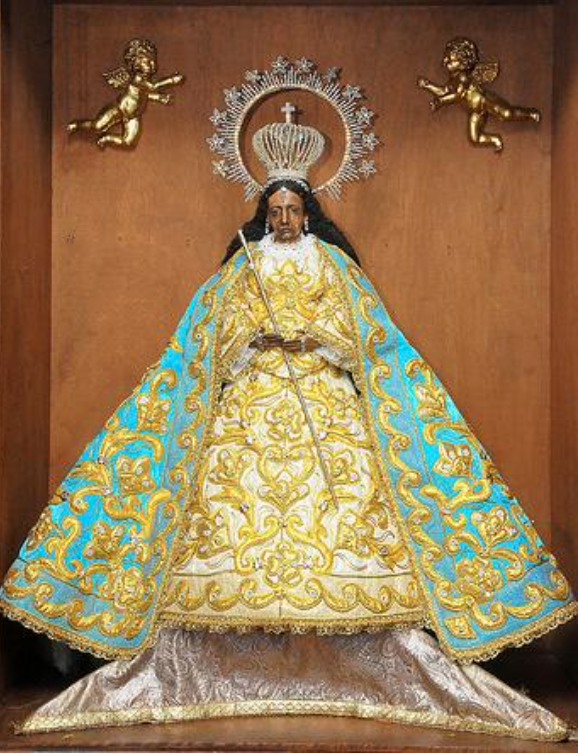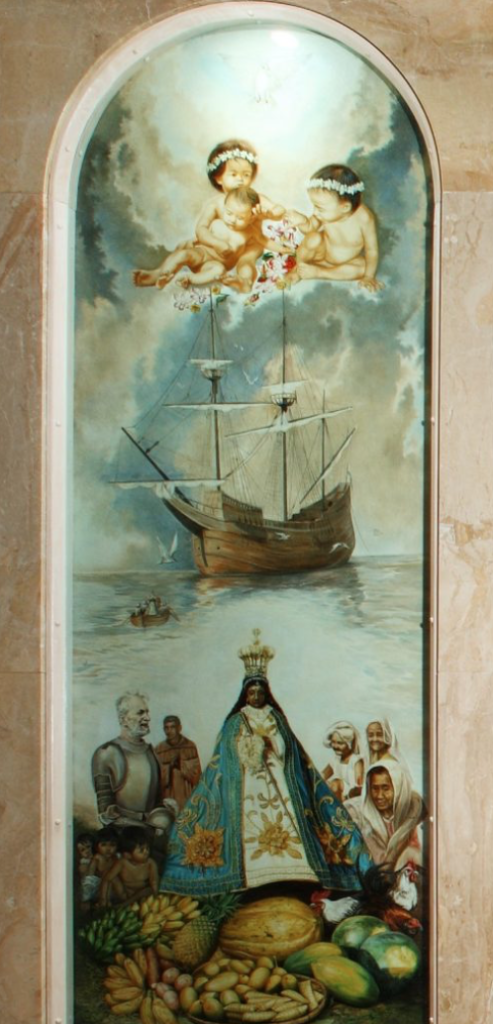Nuestra Señora de la Paz y Buen Viaje
Mahal na Birhen ng Kapayapaan at Mabuting Paglalakbay

Our Lady of Peace and Good Voyage also known as Our Lady of Antipolo and the Virgin of Antipolo is a 17th-century Roman Catholic wooden image of the Blessed Virgin Mary venerated in the Philippines. This statue of the Black Madonna is enshrined in Antipolo Cathedral in the Sierra Madre mountains east of Metro Manila.
The image was brought to the country by governor – general of the Spanish Indies Juan Nino de Tabora from Mexico via the galleon El Almirante in 1626. It was known that whenever the statue was on board the ships crossing the Pacific Ocean from Mexico to the Philippines and back, the ships where protected and did not drown. On the contrary whenever the statue was not on board, few of the ships did not arrive and therefore due to these safe voyage of the governer -general Juan Nino the image was given the title of “Our Lady of Peace and Good Voyage”.
When the Governer Tabora died in 1632, the statue was transferred to the Jesuits to keep it enshrined in the church of Antipolo, which was being built in the place where today it is knows as barangay Santa Cruz.
Apart from being the protector during Pacific Ocean crossings, the statue of Antipolo also has claims of miracles. When the cathedral of Antipolo was being built in the 1930s the statue would mysteriously vanish many times from its shrine and was found on top of the breadfruit tree known as tipolo tree. This was taken as a divine sign that the church is to be transferred to where the tipolo tree stood.
Seven years after the Governer Tabora passed away, the Chinese revolted in the Philippines and burnt down the church of Antipolo. To keep the statue of Our Lady safe, the Governer Sebastian Hurtado de Corcuera, ordered its transferred to Cavite and then transferred back to Mexico on the galleon St Luis. The statue of the Lady of Antipolo served as the protector on board these Acapulco trade between the Philippines and Mexico and has crossed the Pacific six times aboard the following Manila-Acapulco galleons:
San Luis — (1648–1649)
Encarnación — (1650)
San Diego — (1651–1653)
San Francisco Javier — (1659–1662)
Nuestra Señora del Pilar — (1663)
San José — (1746–1748)

A royal decree by Isabella II of Spain on 19 May 1864 ordered that the curias of San Nicolas de Tolentino be turned over to the Jesuits in exchange for the curias of Antipolo, Taytay and Morong, which were given to the Augustinian Recollects. The latter order thus came into possession of the image.
During World War 2, in 1944, the Japanese Army fighting against the Philippines and Americans invaded Antipolo and turned it into a battle ground. To save the image, the church’s head sacristan, Procopio Ángeles, wrapped it in a thick woolen blanket and placed it in an empty petrol drum, which he then buried in a nearby kitchen. Fighting between Japanese troops and the combined American and Filipino forces drove Ángeles and other devotees to take the image and move it to Sitio Colaique on the border with Angono and then to Pasig. The statue was then kept by Rosario Alejandro, daughter of Pablo Ocampo, who was a Philippino Lawyer and Nationalist, at the Ocampo-Santiago family residence in Qiuapo, Manila. It was then enshrined inside Quiapo Church during WW2. On 15th October 1945, the statue was given back to its church in Antipolo, where it remains today
The Diocese of Antipolo was created on 24 January 1983 which has the formal title of “National Shrine of Our Lady of Peace and Good Voyage-Immaculate Conception Parish”. In 2022, Our Lady of Antipolo’s shrine was declared by the Vatican as the first ever international shrine in the Philippines and is also the first Marian international shrine in Asia.
Hence, the statue is one of the most celebrated Marian images in the Philippines, and has been granted Pontifical decree of canonical coronation on 18th June 1925 by Pope Pius XI. The image attracts millions of pilgrims from all over the Philippines and from all over the world especially in the month of May which is dedicated to the Virgin Mary.
Written by: Sarah Azzopardi





